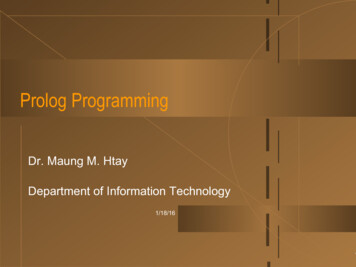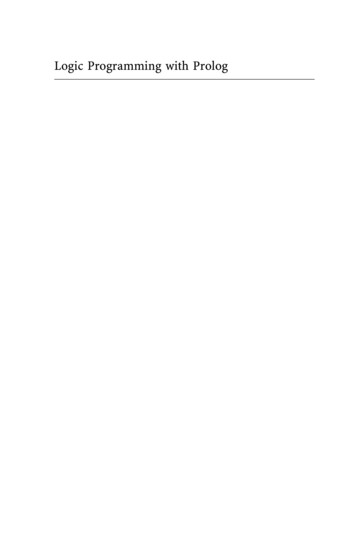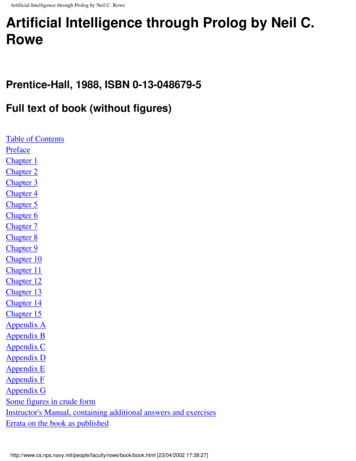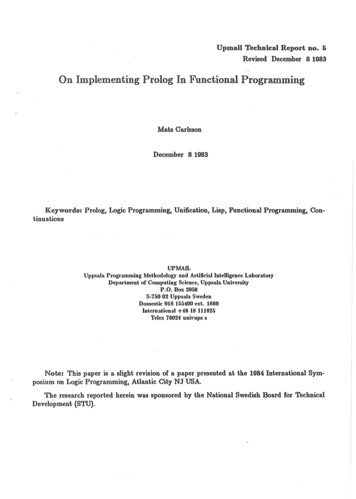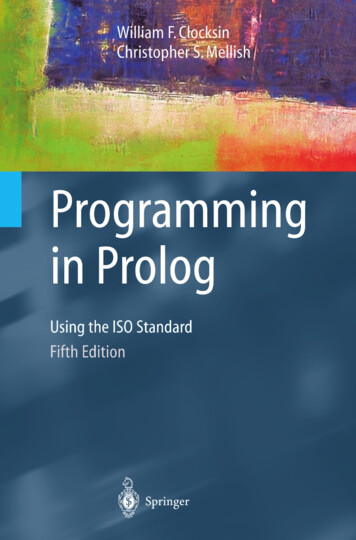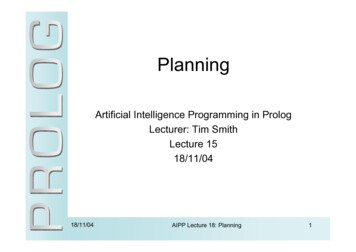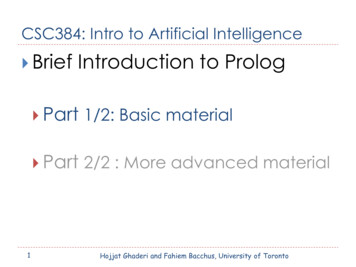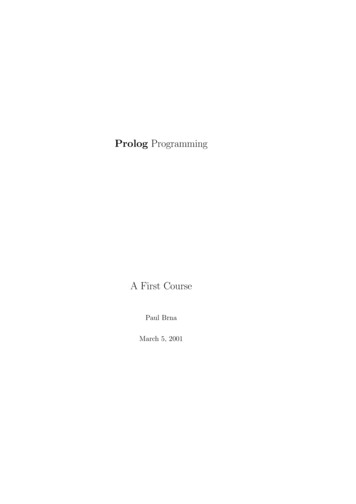
Transcription
Prolog ProgrammingA First CoursePaul BrnaMarch 5, 2001
AbstractThe course for which these notes are designed is intended for undergraduatestudents who have some programming experience and may even have writtena few programs in Prolog. They are not assumed to have had any formalcourse in either propositional or predicate logic.At the end of the course, the students should have enough familiarity withProlog to be able to pursue any undergraduate course which makes use ofProlog.This is a rather ambitious undertaking for a course of only twelve lecturesso the lectures are supplemented with exercises and small practical projectswherever possible.The Prolog implementation used is SICStus Prolog which is closely modelled on Quintus Prolog (SICS is the Swedish Institute of Computer Science).The reference manual should also be available for consultation [SICStus, 1988].c PaulBrna 1988
Contents1 Introduction11.1Declarative vs Procedural Programming . . . . . . . . . . . .11.2What Kind of Logic? . . . . . . . . . . . . . . . . . . . . . . .11.3A Warning . . . . . . . . . . . . . . . . . . . . . . . . . . . .21.4A Request . . . . . . . . . . . . . . . . . . . . . . . . . . . . .22 Knowledge Representation32.1Propositional Calculus . . . . . . . . . . . . . . . . . . . . . .32.2First Order Predicate Calculus . . . . . . . . . . . . . . . . .42.3We Turn to Prolog . . . . . . . . . . . . . . . . . . . . . . .52.4Prolog Constants . . . . . . . . . . . . . . . . . . . . . . . .72.5Goals and Clauses . . . . . . . . . . . . . . . . . . . . . . . .82.6Multiple Clauses . . . . . . . . . . . . . . . . . . . . . . . . .82.7Rules . . . . . . . . . . . . . . . . . . . . . . . . . . . . . . . .92.8Semantics . . . . . . . . . . . . . . . . . . . . . . . . . . . . .102.9The Logical Variable . . . . . . . . . . . . . . . . . . . . . . .112.10 Rules and Conjunctions . . . . . . . . . . . . . . . . . . . . .122.11 Rules and Disjunctions . . . . . . . . . . . . . . . . . . . . . .132.12 Both Disjunctions and Conjunctions . . . . . . . . . . . . . .142.13 What You Should Be Able To Do . . . . . . . . . . . . . . . .153 Prolog’s Search Strategy163.1Queries and Disjunctions. . . . . . . . . . . . . . . . . . . .163.2A Simple Conjunction . . . . . . . . . . . . . . . . . . . . . .193.3Conjunctions and Disjunctions . . . . . . . . . . . . . . . . .213.4What You Should Be Able To Do . . . . . . . . . . . . . . . .234 Unification, Recursion and Lists264.1Unification . . . . . . . . . . . . . . . . . . . . . . . . . . . .264.2Recursion . . . . . . . . . . . . . . . . . . . . . . . . . . . . .274.3Lists . . . . . . . . . . . . . . . . . . . . . . . . . . . . . . . .294.4What You Should Be Able To Do . . . . . . . . . . . . . . . .32i
ii5 The Box Model of Execution345.1The Box Model . . . . . . . . . . . . . . . . . . . . . . . . . .345.2The Flow of Control . . . . . . . . . . . . . . . . . . . . . . .355.3An Example using the Byrd Box Model . . . . . . . . . . . .365.4An Example using an AND/OR Proof Tree . . . . . . . . . .385.5What You Should Be Able To Do . . . . . . . . . . . . . . . .386 Programming Techniques and List Processing6.153The ‘Reversibility’ of Prolog Programs . . . . . . . . . . . .536.1.1Evaluation in Prolog . . . . . . . . . . . . . . . . . .546.2Calling Patterns . . . . . . . . . . . . . . . . . . . . . . . . .556.3List Processing . . . . . . . . . . . . . . . . . . . . . . . . . .566.3.1Program Patterns . . . . . . . . . . . . . . . . . . . .566.3.2Reconstructing Lists . . . . . . . . . . . . . . . . . . .606.4Proof Trees . . . . . . . . . . . . . . . . . . . . . . . . . . . .626.5What You Should Be Able To Do . . . . . . . . . . . . . . . .637 Control and Negation667.1Some Useful Predicates for Control . . . . . . . . . . . . . . .667.2The Problem of Negation . . . . . . . . . . . . . . . . . . . .677.2.1Negation as Failure . . . . . . . . . . . . . . . . . . . .687.2.2Using Negation in Case Selection . . . . . . . . . . . .697.3Some General Program Schemata . . . . . . . . . . . . . . . .707.4What You Should Be Able To Do . . . . . . . . . . . . . . . .778 Parsing in Prolog788.1Simple English Syntax . . . . . . . . . . . . . . . . . . . . . .788.2The Parse Tree . . . . . . . . . . . . . . . . . . . . . . . . . .798.3First Attempt at Parsing. . . . . . . . . . . . . . . . . . . .808.4A Second Approach . . . . . . . . . . . . . . . . . . . . . . .818.5Prolog Grammar Rules . . . . . . . . . . . . . . . . . . . . .828.6To Use the Grammar Rules . . . . . . . . . . . . . . . . . . .838.7How to Extract a Parse Tree . . . . . . . . . . . . . . . . . .838.8Adding Arbitrary Prolog Goals . . . . . . . . . . . . . . . .848.9What You Should Be Able To Do . . . . . . . . . . . . . . . .849 Modifying the Search Space9.186A Special Control Predicate . . . . . . . . . . . . . . . . . . .869.1.1Commit . . . . . . . . . . . . . . . . . . . . . . . . . .869.1.2Make Determinate . . . . . . . . . . . . . . . . . . . .899.1.3Fail Goal Now . . . . . . . . . . . . . . . . . . . . . .90
iii9.29.3Changing the Program . . . . . . . . . . . . . . . . . . . . . .919.2.1Do Not Do It! . . . . . . . . . . . . . . . . . . . . . . .929.2.2Sometimes You have To! . . . . . . . . . . . . . . . . .93What You Should Be Able To Do . . . . . . . . . . . . . . . .9410 Prolog Syntax9710.1 Constants . . . . . . . . . . . . . . . . . . . . . . . . . . . . .9710.2 Variables . . . . . . . . . . . . . . . . . . . . . . . . . . . . .9810.3 Compound Terms . . . . . . . . . . . . . . . . . . . . . . . . .9810.4 (Compound) Terms as Trees . . . . . . . . . . . . . . . . . . .9910.5 Compound Terms and Unification . . . . . . . . . . . . . . .9910.6 The Occurs Check . . . . . . . . . . . . . . . . . . . . . . . . 10010.7 Lists Are Terms Too . . . . . . . . . . . . . . . . . . . . . . . 10110.8 How To Glue Two Lists Together . . . . . . . . . . . . . . . . 10210.9 Rules as Terms . . . . . . . . . . . . . . . . . . . . . . . . . . 10410.10What You Should Be Able To Do . . . . . . . . . . . . . . . . 10511 Operators11211.1 The Three Forms . . . . . . . . . . . . . . . . . . . . . . . . . 11211.1.1 Infix . . . . . . . . . . . . . . . . . . . . . . . . . . . . 11211.1.2 Prefix . . . . . . . . . . . . . . . . . . . . . . . . . . . 11311.1.3 Postfix . . . . . . . . . . . . . . . . . . . . . . . . . . . 11311.2 Precedence . . . . . . . . . . . . . . . . . . . . . . . . . . . . 11311.3 Associativity Notation . . . . . . . . . . . . . . . . . . . . . . 11611.3.1 Infix Operators . . . . . . . . . . . . . . . . . . . . . . 11611.3.2 The Prefix Case . . . . . . . . . . . . . . . . . . . . . 11711.3.3 Prefix Operators . . . . . . . . . . . . . . . . . . . . . 11711.3.4 Postfix Operators . . . . . . . . . . . . . . . . . . . . . 11711.4 How to Find Operator Definitions . . . . . . . . . . . . . . . 11711.5 How to Change Operator Definitions . . . . . . . . . . . . . . 11811.6 A More Complex Example . . . . . . . . . . . . . . . . . . . . 11911.7 What You Should Be Able To Do . . . . . . . . . . . . . . . . 12012 Advanced Features12212.1 Powerful Features . . . . . . . . . . . . . . . . . . . . . . . . . 12212.1.1 Powerful Features —Typing . . . . . . . . . . . . . . . 12212.1.2 Powerful Features —Splitting Up Clauses . . . . . . . 12312.1.3 Powerful Features —Comparisons of Terms . . . . . . 12812.1.4 Powerful Features —Finding All Solutions . . . . . . . 12812.1.5 Powerful Features —Find Out about Known Terms. 130
iv12.2 Open Lists and Difference Lists . . . . . . . . . . . . . . . . . 13112.3 Prolog Layout . . . . . . . . . . . . . . . . . . . . . . . . . . 13612.3.1 Comments . . . . . . . . . . . . . . . . . . . . . . . . . 13612.4 Prolog Style . . . . . . . . . . . . . . . . . . . . . . . . . . . 13812.4.1 Side Effect Programming . . . . . . . . . . . . . . . . 13812.5 Prolog and Logic Programming . . . . . . . . . . . . . . . . 14012.5.1 Prolog and Resolution . . . . . . . . . . . . . . . . . 14012.5.2 Prolog and Parallelism . . . . . . . . . . . . . . . . . 14012.5.3 Prolog and Execution Strategies . . . . . . . . . . . . 14112.5.4 Prolog and Functional Programming . . . . . . . . . 14112.5.5 Other Logic Programming Languages . . . . . . . . . 14112.6 What You Should Be Able To Do . . . . . . . . . . . . . . . . 141A A Short Prolog Bibliography142B Details of the SICStus Prolog Tracer145C Solutions and Comments on Exercises for Chapter ?148C.1 Exercise 2.1 . . . . . . . . . . . . . . . . . . . . . . . . . . . . 148C.2 Execise 2.2 . . . . . . . . . . . . . . . . . . . . . . . . . . . . 149C.3 Exercise 2.3 . . . . . . . . . . . . . . . . . . . . . . . . . . . . 150C.4 Exercise 2.4 . . . . . . . . . . . . . . . . . . . . . . . . . . . . 150C.5 Exercise 2.5 . . . . . . . . . . . . . . . . . . . . . . . . . . . . 151C.6 Exercise 2.6 . . . . . . . . . . . . . . . . . . . . . . . . . . . . 152C.7 Exercise 2.7 . . . . . . . . . . . . . . . . . . . . . . . . . . . . 152D Solutions and Comments on Exercises for Chapter ?155D.1 Exercise 3.1 . . . . . . . . . . . . . . . . . . . . . . . . . . . . 155D.2 Exercise 3.2 . . . . . . . . . . . . . . . . . . . . . . . . . . . . 156E Solutions and Comments on Exercises for Chapter ?160E.1 Exercise 4.1 . . . . . . . . . . . . . . . . . . . . . . . . . . . . 160E.2 Exercise 4.2 . . . . . . . . . . . . . . . . . . . . . . . . . . . . 160E.3 Exercise 4.3 . . . . . . . . . . . . . . . . . . . . . . . . . . . . 162F Solutions and Comments on Exercises for Chapter ?165F.1 Exercise 6.1 . . . . . . . . . . . . . . . . . . . . . . . . . . . . 165G Solutions and Comments on Exercises for Chapter ?175G.1 Exercise 8.1 . . . . . . . . . . . . . . . . . . . . . . . . . . . . 175H Solutions and Comments on Exercises for Chapter ?178H.1 Exercise 9.1 . . . . . . . . . . . . . . . . . . . . . . . . . . . . 178
ISolutions and Comments on Exercises for Chapter ?I.1Exercise 11.1 . . . . . . . . . . . . . . . . . . . . . . . . . . . 183J Solutions and Comments on Exercises for Chapter ?J.1183184Exercise 12.1 . . . . . . . . . . . . . . . . . . . . . . . . . . . 184
List of Figures3.1A Failed Match . . . . . . . . . . . . . . . . . . . . . . . . . .183.2A Successful Match . . . . . . . . . . . . . . . . . . . . . . . .205.1The Byrd Box Model Illustrated . . . . . . . . . . . . . . . .345.2Illustrating Simple Flow of Control . . . . . . . . . . . . . . .365.3Program Example with Byrd Box Representation . . . . . . .375.4The AND/OR Tree for the Goal a(X,Y) . . . . . . . . . . .385.5The Development of the AND/OR Proof Tree . . . . . . . . .395.6Yuppies on the Move . . . . . . . . . . . . . . . . . . . . . . .526.1The Proof Tree for triple([1,2],Y) . . . . . . . . . . . . . . .626.2The Proof Tree for triple([1,2],[],Y) . . . . . . . . . . . . .638.1A Parse Tree . . . . . . . . . . . . . . . . . . . . . . . . . . .799.1The Effect of cut on the AND/OR Tree . . . . . . . . . . . .889.2The First Solution to the Goal sum(2,Ans) . . . . . . . . .909.3Resatisfying the Goal sum(2,Ans) . . . . . . . . . . . . . . .919.4The Effect of the cut on the Goal sum(2,Ans) . . . . . . . .92
PrefaceA WarningThese notes are under development. Much will eventually change. Pleasehelp to make these notes more useful by letting the author know of anyerrors or missing information. Help future generations of AI2 students!The Intended AudienceThe course for which these notes are designed is intended for undergraduatestudents who have some programming experience and may even have writtena few programs in Prolog. They are not assumed to have had any formalcourse in either propositional or predicate logic.The ObjectiveAt the end of the course, the students should have enough familiarity withProlog to be able to pursue any undergraduate course which makes use ofProlog.The original function was to provide students studying Artificial Intelligence(AI) with an intensive introduction to Prolog so, inevitably, there is a slightbias towards AI.The AimsAt the end of the course the students should be: familiar with the basic syntax of the language able to give a declarative reading for many Prolog programs able to give a corresponding procedural reading able to apply the fundamental programming techniques familiar with the idea of program as data able to use the facilities provided by a standard trace package to debugprograms familiar with the fundamental ideas of the predicate calculus familiar with the fundamental ideas specific to how Prolog worksvii
viiiCourse StructureThis is a rather ambitious undertaking for a course of only twelve lecturesso the lectures are supplemented with exercises and small practical projectswherever possible.AcknowledgementsThese notes are based on a previous version used with the students of the AI2course in Prolog during the session 1985–87 and 1988–89 at the Departmentof Artificial Intelligence, Edinburgh University. My thanks for the feedbackthat they supplied.
Chapter 1Introductionintro-chapProlog is PROgramming in LOGicA few points must be cleared up before we begin to explore the main aspectsof Prolog.These notes are supplemented with exercises and suggestions for simple practicals. It is assumed that you will do most of this supplementary work eitherin your own time, for tutorials or during practical sessions.Each chapter will start with a simple outline of its content and finish witha brief description of what you should know upon completion of the chapterand its exercises.Important points will be boxed and some technical and practical detailswhich are not immediately essential to the exposition will bewritten in a smaller font.1.1Declarative vs Procedural ProgrammingProcedural programming requires that the programmer tell the computerwhat to do. That is, how to get the output for the range of required inputs.The programmer must know an appropriate algorithm.Declarative programming requires a more descriptive style. The programmermust know what relationships hold between various entities.Pure1 Prolog allows a program to be read either declaratively or procedurally. This dual semantics is attractive.1.2What Kind of Logic?Prolog is based on First Order Predicate Logic —sometimes abbreviatedto FOPL.1Prolog, like LISP, has a pure subset of features. The implication is that some featuresof both languages are regarded as impure —these are often provided for efficiency or foruseful, but strictly unnecessary features. The impure features of Prolog damage thepleasing equality between the declarative and procedural readings of Prolog programs.1
2Introduction to PrologFirst order predicate logic implies the existence of a set of predicate symbolsalong with a set of connectives.First order predicate logic implies that there is no means provided for “talking about” the predicates themselves.Prolog is based on FOPL but uses a restricted version of the clausal form.Clausal form is a particular way of writing the propositions of FOPL. Therestriction is known as Horn clause form.Prolog is a so-called logic programming language. Strictly, it is not the onlyone but most such languages are its descendents.We will spend a little time outlining the basic ideas underlying both propositional and predicate logic. It is not the intention to use Prolog as a vehicleto teach logic but some appreciation of the issues is invaluable.1.3A WarningProlog is known to be a difficult language to master. It does not have thefamiliar control primitives used by languages like RATFOR, ALGOL andPASCAL so the system does not give too much help to the programmer toemploy structured programming concepts.Also, many programmers have become used to strongly typed languages.Prolog is very weakly typed indeed. This gives the programmer great powerto experiment but carries the obvious responsibility to be careful.Another major difference is the treatment of variables —special attentionshould be given to understanding variables in Prolog.Prolog provides a search strategy for free —there is a cost. The programmer has to develop a methodology to handle the unexpected consequencesof a faulty program. In particular, pay careful attention to the issue ofbacktracking.It is usual to assume that telling people how they can go wrong is an encouragement to do exactly that —go wrong. The approach taken here is tomake the known difficulties explicit.1.4A RequestThese notes are slowly being improved. Many further exercises need to beadded along with more example programs and improvements to the text.If you have any comments that will help in the development of these notesthen please send your comments to:Paul BrnaDepartment of Artificial IntelligenceUniversity of Edinburgh80 South BridgeEdinburgh EH1 1HN
Chapter 2Knowledge RepresentationKRchapterWe take a very brief and informal look at both the propositionalcalculus and first order predicate logic.We then restrict our attention to a form of predicate logic whichtranslates directly into Prolog.This requires that we introduce a simple vocabulary that describes the syntax of Prolog.Here, we concentrate on an informal description of the fundamental units which are:clause, rule, fact,goal, subgoal,logical variable, constant, atom,functor, argument, arity.An explanation as to how statements can be represented inProlog form is given.How do we represent what we know? The simplest analysis requires that wedistinguish between knowledge how –procedural knowledge such as how todrive a car— and knowledge that —declarative knowledge such as knowingthe speed limit for a car on a motorway.Many schemes for representing knowledge have been advanced —includingfull first order predicate logic. The strong argument for classical (first orderpredicate) logic is that it has a well understood theoretical foundation.2.1Propositional CalculusThe propositional calculus is based on statements which have truth values(true or false).The calculus provides a means of determining the truth values associatedwith statements formed from “atomic” statements. An example:If p stands for “fred is rich” and q for “fred is tall” then we may form statements such as:3
4Knowledge RepresentationSymbolic Statementp qp qp qp q pTranslationp or qp and qp logically implies qp is logically equivalent to qnot pNote that , , and are all binary connectives. They are sometimesreferred to, respectively, as the symbols for disjunction, conjunction, implication and equivalence. Also, is unary and is the symbol for negation.If propositional logic is to provide us with the means to assess the truthvalue of compound statements from the truth values of the ‘building blocks’then we need some rules for how to do this.For example, the calculus states that p q is true if either p is true or q istrue (or both are true). Similar rules apply for all the ways in which thebuilding blocks can be combined.A ProblemIf p stands for “all dogs are smelly” and p is true then we would like to beable to prove that “my dog fido is smelly”.We need to be able to get at the structure and meaning of statements. Thisis where (first order1 ) predicate logic is useful.2.2First Order Predicate CalculusThe predicate calculus includes a wider range of entities. It permits thedescription of relations and the use of variables. It also requires an understanding of quantification.The language of predicate calculus requires:VariablesConstants —these include the logical constantsSymbol Meaningorandnotlogically implieslogically equivalentfor allthere existsThe last two logical constants are additions to the logical connectivesof propositional calculus —they are known as quantifiers. The nonlogical constants include both the ‘names’ of entities that are relatedand the ‘names’ of the relations. For example, the constant dog mightbe a relation and the constant fido an entity.1Do not worry about the term first order for now. Much later on, it will becomerelevant.
5Predicate —these relate a number of entities. This number is usuallygreater than one. A predicate with one argument is often used toexpress a property e.g. sun(hot) may represent the statement that“the sun has the property of being hot”.If there are no arguments then we can regard the ‘predicate’ as standing for a statement à la the propositional calculus.Formulæ —these are constructed from predicates and formulæ2 . The logical constants are used to create new formulæ/ from old ones. Hereare some examples:Formula(e)dog(fido)dog(fido) anddog(fido) anddog(fido) anddog(fido) )New Formula dog(fido)dog(fido) old(fido)dog(fido) old(fido)dog(fido) old(fido)dog(fido) old(fido) X.dog(X) X.dog(X)Note that the word “and” used in the left hand column is used tosuggest that we have more than one formula for combination —andnot necessarily a conjunction.In the last two examples, “dog(X)” contains a variable which is saidto be free while the “X” in “ X.dog(X)” is bound.Sentence —a formula with no free variables is a sentence.Two informal examples to illustrate quantification follow: X.(man(X) mortal(X)) X.elephant(X)All men are mortalThere is at least one elephantThe former is an example of universal quantification and the latter of existential quantification.We can now represent the problem we initially raised: X.(dog(X) smelly(X)) dog(fido) smelly(fido)To verify that this is correct requires that we have some additional machinerywhich we will not discuss here.2.3We Turn to PrologProlog provides for the representation of a subset of first order predicatecalculus. The restrictions on what can be done will become clearer later.We will now explain how we can write logical statements in Prolog.2Note that this is a recursive definition.
6Knowledge RepresentationIf “the capital of france is paris” then we can represent this in predicatecalculus form as3 :france has capital parisWe have a binary relationship (two things are related) written in infix form.That is, the relationship is written between the two things related.The relationship (or predicate) has been given the name “has capital” —hence we say that the predicate name is “has capital”.And in Prolog form by such as:has capital(france,paris).where we write a prefix form and say that the relationship takes two arguments. Prefix because the relationship is indicated before the two relatedthings.Note that, in Prolog, if the name of an object starts with a lower case letterthen we refer to a specific object. Also, there must be no space between thepredicate name and the left bracket “(”. The whole thing also ends in a “.”as the last character on the line.The exact rule for the termination of a clause is that a clause must endwith a “.” followed by white space where white space can be any of{space,tab,newline,end of file}. It is safest to simply put “.” followedby newline.Also note that relations do not need to hold between exactly two objects.For example,meets(fred,jim,bridge)might be read asfred meets jim by the bridgeHere, three objects are related so it makes little sense to think of the relationmeets as binary —it is ternary.If we can relate two objects or three then it is reasonable to relate n wheren 2. Is there any significance to a relationship that relates one or evenzero objects? A statement likejim is tallmight be represented either as3The failure to capitalise “france” and “paris” is quite deliberate. In Prolog, named,specific objects (i.e. the atoms) usually start with a lower case letter.
7tall(jim)orjim(tall)It is, perhaps, preferable to see tallness as being a property which is possessed by jim.A ‘relation’ that has no arguments can be seen as a single proposition. Thusthe binary relation “france has capital paris” above might be rewritten asthe statement “france has capital paris” —a relation with no arguments.2.4Prolog ConstantsIf we haveloves(jane,jim).then jane and jim refer to specific objects. Both jane and jim are constants. In particular, in DEC-10 Prolog terminology, both are atoms. Also,“loves” happens to be an atom too because it refers to a specific relationship.Generally speaking, if a string of characters starts with a lower case letter,the DEC-10 family of Prologs assume that the entity is an atom.There are constants other than atoms —including integers and real numbers.A constant is an atom or a number. A number is an integer or a realnumber4 . The rules for an atom are quite complicated:quoted itemwordsymbolspecial item’anything but the single quote character’lower case letter followed by any letter, digit or (underscore)any number of { , -, *, /, \, , , , , ’, , :, ., ?, @, #, , &}any of { [], {}, ;, !, %}So the following are all atoms:likes chocolate, fooX23, * , :: , ’What Ho!’By the way, you can include a single quote within a quoted atom —justduplicate the single quote. This gives the quoted atom with a singlequote as:’’’’A practical warning: remember to pair off your (single) quote signswhen inputing a quoted atom or Prolog may keep on swallowing yourinput looking for that elusive single quote character. This is one of themost common syntactic errors for beginners.While we are on the subject, another common error is to assume thata double quote (") behaves like a single quote —i.e. that the term"Hello" is an atom just like ’Hello’. This is not so. When you dofind out what sensible things can be done with the double quote thenremember to pair them off.4Referred to as a float in the SICStus Prolog manual [SICStus, 1988].
8Knowledge RepresentationBecause Prolog is modelled on a subset of first order predicate logic, allpredicate names must be constants —but not numbers. In particular,No predicate may be a variableThat is, we cannot have X(jane,jim) as representing the fact that janeand jim are related in some unknown way.2.5Goals and ClausesWe distinguish between a Prolog goal and Prolog clause. A clause is thesyntactic entity expressing a relationship as required by Prolog —note thatwe will regard the ‘.’ as terminating a clause (this is not strictly correct).loves(jane,jim)loves(jane,jim).is a goalis a unit clauseThe adjectives unit and non-unit distinguish two kinds of clause —intuitively,facts and rules respectively.Exercise 2.1 Here is the first opportunity to practice the representation ofsome statement in Prolog form.1. bill likes ice-cream2. bill is tall3. jane hits jimmy with the cricket bat4. john travels to london by train5. bill takes jane some edam cheese6. freddy lives at 16 throgmorton street in londonThe failure to capitalise “freddy”, “london” etc. is a reminder that the version of Prolog that we are using requires that constants should not startwith an upper case letter.Note that there may be several ways of representing each of these statements.2.6Multiple ClausesA predicate may be defined by a set of clauses with the same predicate nameand the same number of arguments.We will therefore informally describe the way in which this is handledthrough an example. The logical statement (in first order form)squared(1,1) squared(2,4) squared(3,9)is to be represented as three distinct Prolog clauses.
9squared(1,1).squared(2,4).squared(3,9).Note that this way of turning a conjunctive statement into Prolog is oneof the fundamental restrictions previously mentioned. There are more tofollow.All the above clauses are unit clauses —this is not a necessary requirement.See section 2.12 for an example with both unit and non-unit clauses.We now introduce a graphical representation which will be used in a numberof different ways. The idea we use here is to represent a program (in thiscase, consisting of a set of unit clauses) as a tree.(((((((((squared(1,1)(((( hhhhhhhsquared(2,4)hhhhhhsquared(3,9)This tree is an example of an OR tree.It might have been expected that we would call this an AND tree but, whenwe are trying to determine whether a statement such as squared(1,1) istrue then we might use either the first clause or the second or the third andso on.Exercise 2.2 Represent each of these statements as a set of Prolog clauses.1. bill only eats chocolate, bananas or cheese.2. the square root of 16 is 4 or -4.3. wales, ireland and scotland are all countries.2.7RulesThe format is:divisible by two:even.This is a non-unit clause.In general, a clause consists of two parts: the head and the body5 .The head is divisible by two and the body is even —even is sometimesreferred to as a subgoal.5These two body parts are ‘joined’ by the neck. There is an analogous concept in theProlog literature.
10Knowledge RepresentationNote that the symbol “:-” is read as if. An informal reading of the clause is“divisible by two is true if even is true” which is equivalent to “even divisible by two”.Any number of subgoals may be in the body of the rule.No more than one goal is allowed in the headThis is another way in which Prolog is a restriction of full first order predicate calculus. For example, we cannot translate rich(fred) happy(fred) powerful(fred)directly into the Prolog version happy(fred),powerful(fred) :- rich(fred).See section 2.10 for an example of a clause with more than one subgoal inthe body. A fact is effectively a rule with no subgoals.You may have noticed that, even if it is held that “even” is a relation, itdoes not seem to relate anything to anything else.The rule is not as much use as it might be because it does not reveal themore interesting relationship thatA number is divisible by two if it is evenWe can express this with the help of the logical variable. Here is the improved rule:divisible by two(X):even(X).This is also a non-unit clause. The named logical variable is X. This Prologclause is equivalent to the predicate calculus statement X. (even(X) divisible by two(X)).2.8SemanticsHere is an informal version of the procedural semantics for the exampleabove:If we can find a value of X that satisfies the goal even(X)then we have also found a number that satisfies the goal divisible by tw
of Artificial Intelligence, Edinburgh University. My thanks for the feedback that they supplied. Chapter 1 Introduction intro-chap Prolog is PROgramming in LOGic A few points must be cleared up before we begin to explore the main aspects of Prolog. These notes are sup

